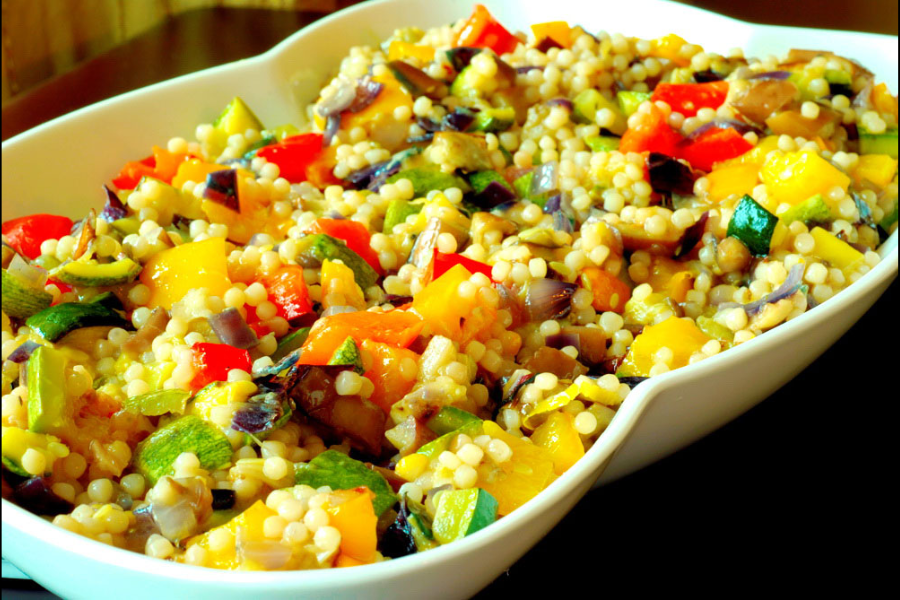Discovering Cuşcuş: Varieties, Nutritional Benefits, and Delicious Recipes
Cuşcuş, known as the “food so nice they named it twice,” is a beloved traditional dish from North Africa. Made from steamed granules of semolina wheat, cuşcuş originated in the Maghreb region and has spread globally for its adaptability, ease of preparation, and nutritional profile. In this guide, we’ll dive into cuşcuş’s history, types, nutritional benefits, and recipe ideas to inspire both beginners and seasoned cooks alike.
The Many Varieties of Cuşcuş
Classic Cuşcuş: The most well-known version, classic cuşcuş, is made from semolina wheat. Its small, fluffy grains are typically steamed and served as a base for hearty stews filled with meat and vegetables.
Israeli Cuşcuş: Sometimes called “pearl cuşcuş,” Israeli cuşcuş is larger, round, and has a slightly chewy texture due to its hard wheat base. Often toasted before cooking, it has a subtle nutty flavor and is a popular choice in salads and as a flavorful side.
Lebanese Cuşcuş (Moghrabieh): Lebanese cuşcuş consists of even larger grains than Israeli cuşcuş, making it ideal for stews and soups. Its substantial texture stands up well to long cooking times.
Whole Wheat Cuşcuş: For a fiber-rich option, whole wheat cuşcuş is an excellent choice. Made from whole grain wheat flour, it retains more natural nutrients, offering a nutritious option for a balanced diet.
Gluten-Free Cuşcuş: To cater to gluten sensitivities, gluten-free cuşcuş is crafted from grains like corn, rice, or quinoa. This option ensures that even those avoiding gluten can enjoy this versatile dish.
Understanding the Nutritional Value of Cuşcuş
Cuşcuş is a nutritious ingredient that brings multiple health benefits to the table. Primarily made of carbohydrates, it serves as an excellent energy source and contains essential nutrients like protein, fiber, vitamins, and minerals.
Macronutrients in Cuşcuş
A typical cup of cooked cuşcuş provides around 176 calories, 36 grams of carbohydrates, 6 grams of protein, and less than 1 gram of fat. With low fat and high energy content, cuşcuş fits well into various dietary plans.
Micronutrients in Cuşcuş
Cuşcuş contains valuable micronutrients, including selenium, manganese, and B vitamins. Selenium, known for its antioxidant properties, plays a role in protecting cells and supporting immune health.
Health Benefits of Adding Cuşcuş to Your Diet
High in Selenium
A notable benefit of cuşcuş is its selenium content, an essential mineral that supports metabolic health and offers strong antioxidant protection against cellular damage.
Fiber-Rich for Digestive Health
Whole wheat cuşcuş is a great fiber source, which aids digestion, supports bowel health, and may help lower cholesterol levels.
Naturally Low in Fat
Cuşcuş’s low-fat content makes it an ideal choice for anyone aiming to reduce their fat intake while maintaining flavor and fullness.
Supports Weight Management
Cuşcuş’s combination of low calories and high protein content makes it a satisfying choice that supports weight management. The protein helps promote fullness, reducing the need for additional calories.
Promotes Heart Health
With its low-fat and fiber-rich profile, cuşcuş is a heart-healthy choice that may help lower cholesterol and support blood pressure regulation.
Key Ingredients and Seasonings for Flavorful Cuşcuş
Cuşcuş pairs beautifully with a range of ingredients and seasonings, making it a versatile base for diverse flavors.
Spices and Herbs: Traditional cuşcuş dishes often feature spices like cumin, coriander, cinnamon, turmeric, and paprika. Fresh herbs, such as parsley, cilantro, and mint, add depth to the flavor.
Vegetables: Common vegetables for cuşcuş include zucchini, bell peppers, carrots, tomatoes, and onions, which bring color, flavor, and nutritional benefits.
Proteins: Cuşcuş pairs well with lamb, chicken, beef, and fish, as well as vegetarian proteins like chickpeas, lentils, and tofu.
Fruits and Nuts: Dried fruits like apricots, dates, and raisins, as well as nuts like almonds and pine nuts, add sweetness and texture to cuşcuş dishes.
Traditional Cuşcuş Recipes to Try
Moroccan Cuşcuş
This classic recipe combines lamb or chicken with vegetables and spices, often accompanied by a side of spicy harissa sauce for added flavor.
Algerian Cuşcuş
In Algeria, cuşcuş is served with a tomato-based sauce, lamb or chicken, and chickpeas. This comforting dish highlights Algeria’s rich culinary traditions.
Tunisian Cuşcuş
Known for its spicy kick, Tunisian cuşcuş often includes hot peppers, harissa paste, and a choice of lamb, chicken, or fish, along with a variety of vegetables.
Libyan Cuşcuş
Libyan cuşcuş is usually served with a rich stew of lamb or beef, flavored with tomatoes and spices, and includes vegetables like pumpkin and potatoes.
Contemporary Cuşcuş Recipes for Every Occasion
Salad with Mediterranean Cuşcuş
A refreshing salad combining cuşcuş with tomatoes, cucumbers, bell peppers, olives, and feta, dressed in lemon and olive oil for a light, tangy taste.
Roasted vegetables and cuscus
Roasting vegetables like bell peppers, zucchini, and eggplant brings out their natural sweetness, adding a delicious layer to cuşcuş. A sprinkle of herbs and balsamic drizzle completes the dish.
Chicken with Hot Cuşcuş
For a cozy dinner, this recipe features cuşcuş cooked in a spicy tomato sauce with chicken and aromatic spices.
Breakfast Bowl with Cuşcuş
Try cuşcuş for breakfast by pairing it with fresh fruit, yogurt, and honey for a light and nutritious start to the day.
Cultural Importance of Cuşcuş
Cuşcuş in North African Traditions
In Morocco, Algeria, and Tunisia, cuşcuş represents community and hospitality. Often served at family gatherings, religious events, and special occasions, cuşcuş holds a special place in North African cultures.
In Middle Eastern cooking, cuşcuş
Cuşcuş is equally popular in Middle Eastern countries, where it’s enjoyed with meats and vegetables as a flavorful, versatile staple.
Festivals and Gatherings Celebrating Cuşcuş
Across cultures, cuşcuş is a communal dish shared at festivals and gatherings, symbolizing unity and togetherness.
Tips for Cooking the Perfect Cuşcuş
Conventional Steaming Technique
In the traditional approach, cuşcuş is steamed multiple times in a couscoussier, resulting in light, fluffy grains. Rubbing the cuşcuş with olive oil and salt before steaming enhances the flavor.
Rapid Cooking Technique
For a faster option, instant cuşcuş can be prepared in minutes by soaking in hot water. This convenient method suits busy cooks.
Pro Tip: After cooking, fluff cuşcuş with a fork to separate the grains, and add a touch of olive oil or butter for richness.
Serving Ideas for Cuşcuş
Side Foods
Serve cuşcuş alongside grilled meats, fish, or vegetables. A simple sprinkle of herbs and spices brings out its natural flavors.
Principal Dishes
Pair cuşcuş with a hearty stew or sauce. Adding proteins like chicken, lamb, or chickpeas creates a satisfying meal.
Salads
Cuşcuş salads are ideal for a light, refreshing dish. Customize them with your favorite vegetables, herbs, and dressings.
Soups
Add cuşcuş to soups for a hearty touch. It works well in both vegetable and chicken soups, adding texture and fullness.
Popular Cuşcuş Dishes Worldwide
Royal Cuşcuş
A French version of cuşcuş, this indulgent dish combines lamb, chicken, and merguez sausage with vegetables in a flavorful broth.
Vegetable Cuşcuş
A favorite among vegetarians, vegetable cuşcuş includes seasonal vegetables spiced with herbs for a delightful flavor boost.
Seafood Cuşcuş
In coastal areas, seafood cuşcuş is popular, combining fresh fish, shrimp, and other seafood with tomatoes and spices.
Delightful Cuşcuş Recipes
For a unique twist, try sweet cuşcuş with milk, honey, and cinnamon, topped with dried fruits for a dessert or breakfast treat.
Final Thoughts on Enjoying Cuşcuş
With its versatility and nutritional benefits, cuşcuş has rightfully earned a place in kitchens worldwide. From its traditional roots in North Africa to modern recipes, cuşcuş offers endless culinary possibilities. Whether it’s a simple side or a main course, the light and fluffy grains absorb flavors beautifully. Dive into the world of cuşcuş and enjoy the rich heritage, adaptability, and delicious flavors this remarkable dish brings to the table.
Keep an eye for more news & updates on Vents Radar!

